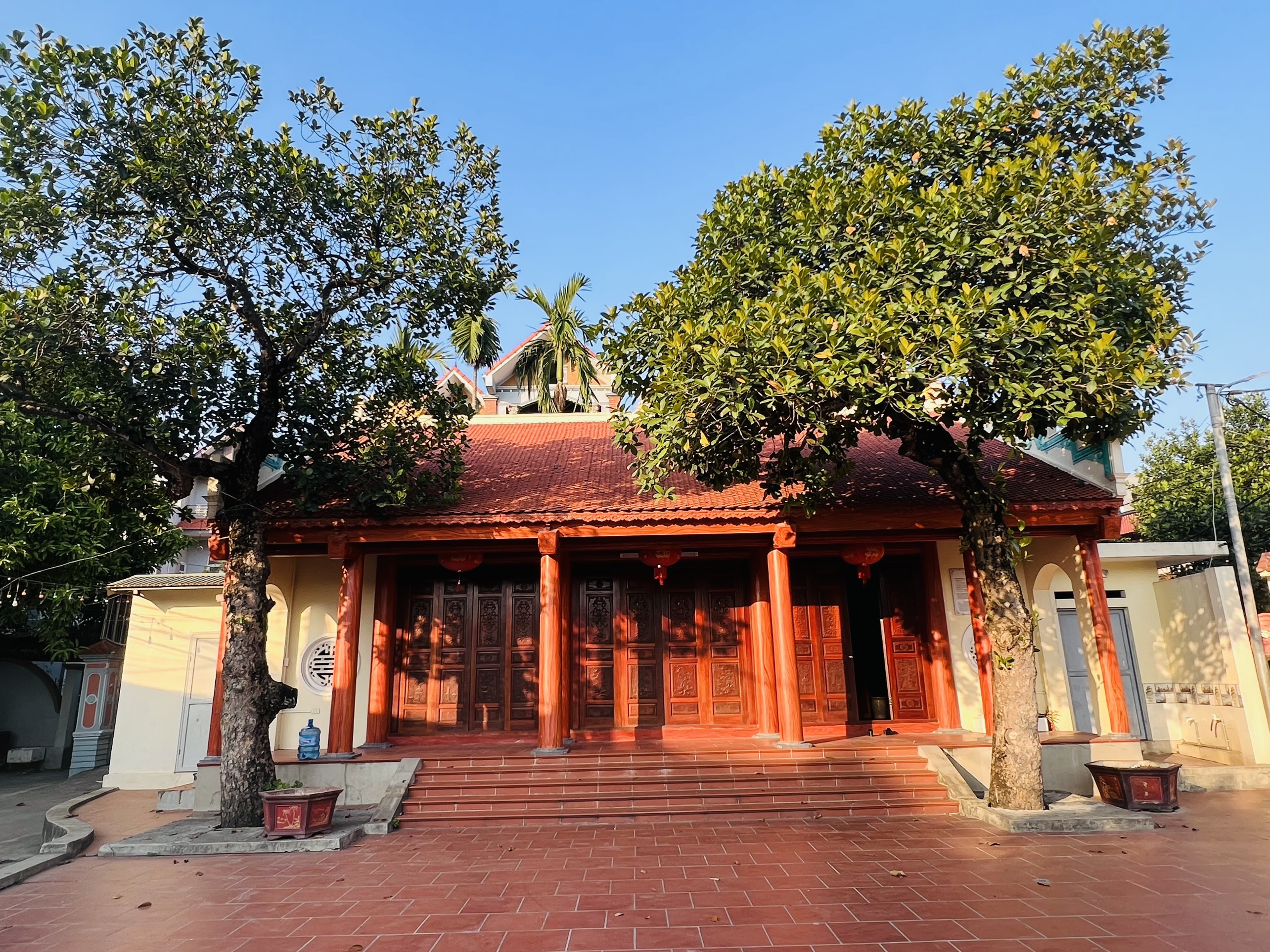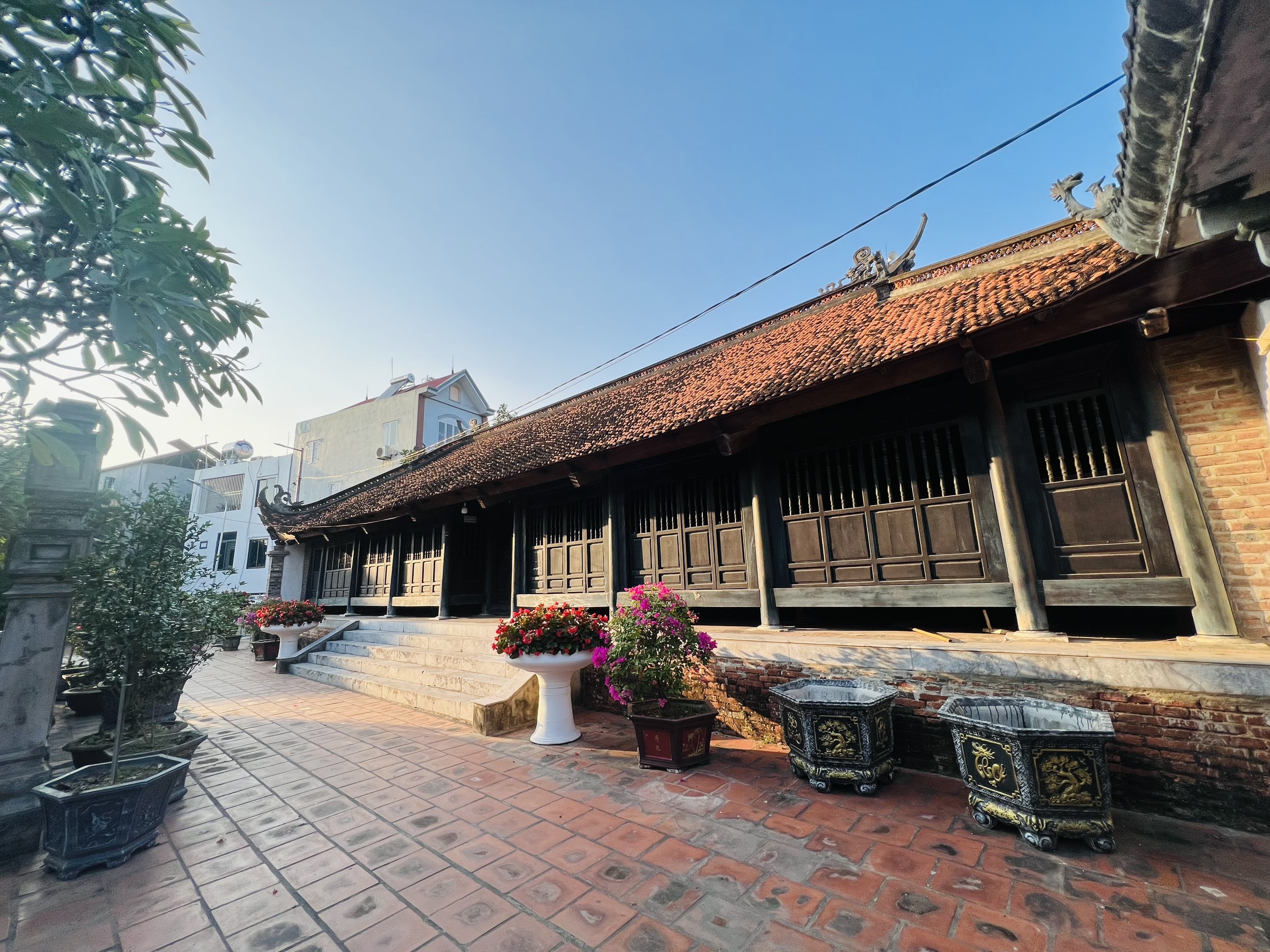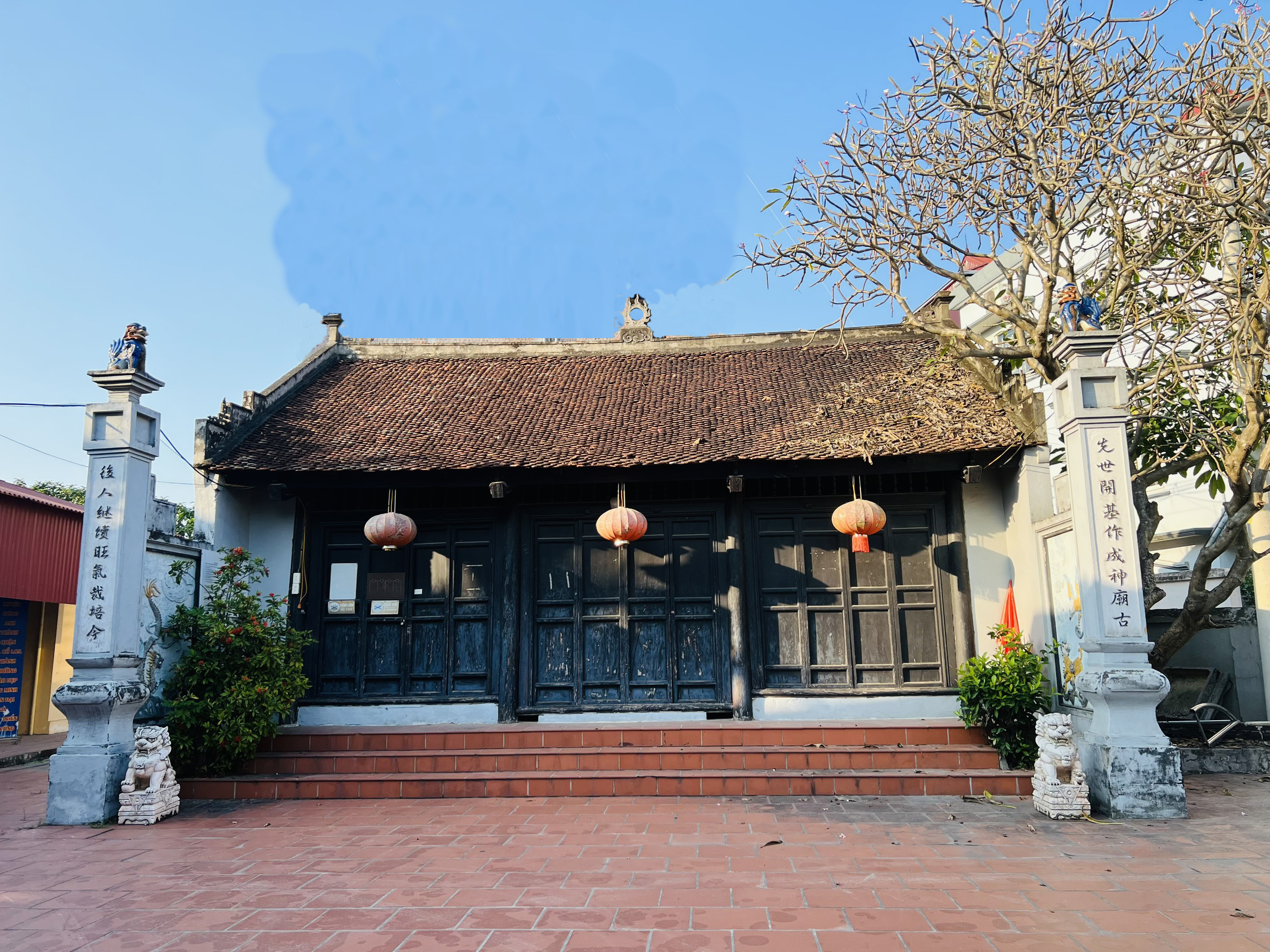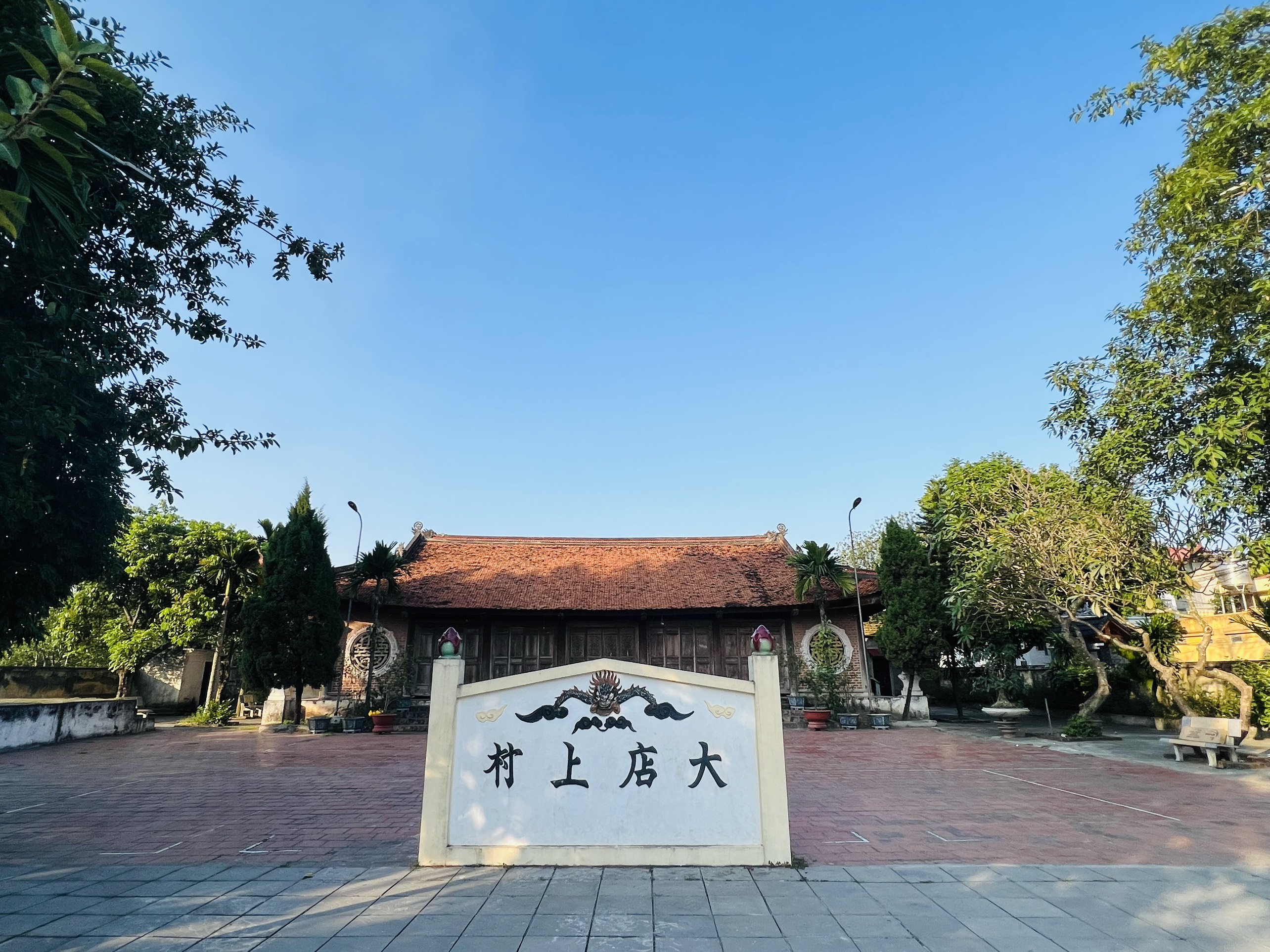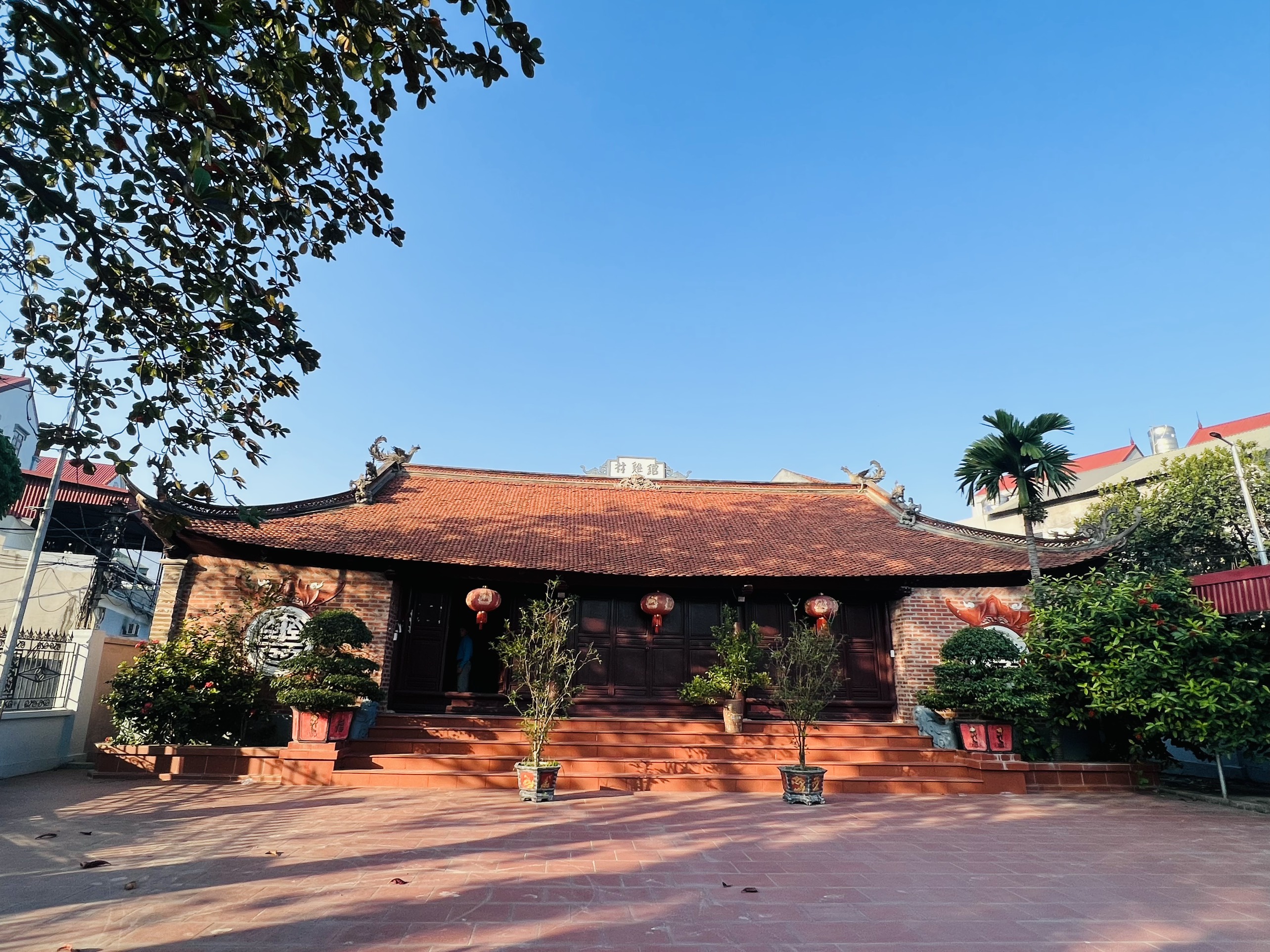
Gà Hamlet is located in the west of Internal rampart, close to Middle rampart to the southwest. According to tradition, from the time of An Dương Vương, this area often held cock fighting and was a gathering place for cock fighting, so it was named Chicken hamlet.
 Chicken Hamlet Điếm
Chicken Hamlet Điếm
“Điếm” is located next to the North-South road, at the beginning of the village, facing south, in front of a rectangular pond. The road, near the gate, there is a round well built of Bát Tràng bricks, next to it is a shrine to worship the water god. The architecture of the “điếm” has the shape of Chinese word "丁". The Forecourt consists of 5 compartments and 2 hips, he distance between the compartments is quite wide, and it is on a platform about one meter high. The roof is covered with Shoe-toe-shaped tiles with four curved corners, the roof edge is decorated with lemon flowers and the mascot of the Four Supernatural Creatures: dragon on the four ends, small lion on the front roof edge, phoenix on the two ends of the roof. In the middle of the roof, the name of “điếm” is inscribed with Chinese characters in a "three-level" name board: Gà hamlet điếm, below is a tiger face. With such a structure, the Forecourt looks very majestic.
Các bộ vì kèo gỗ của tiền tế được làm theo kiểu “chồng rường, kẻ bẩy” với bốn hàng chân cột khá cao lớn. Trên các con chồng và đầu nghé, đầu bẩy có chạm vân mây hoa lá cách điệu khá mềm mại tinh tế. Theo các cụ cao niên ở địa phương, bộ khung gỗ ở điếm được mua ở nơi khác về từ cách đây khá lâu, chính là một cái đình của địa phương khác, có niên đại khoảng 150 năm về trước. Năm 2004 đã có một cuộc tu bổ lớn đã sửa chữa cả nội ngoại thất của ngôi điếm và cổng đường đi sân vườn của khu vực này.
The wooden trusses of the forecourt are made in the style of “chồng rường, kẻ bẩy” with four rows of columns. On the primary wooden trusses re carved with delicate stylized clouds and flowers. According to the local seniors, the wooden frame was bought from elsewhere quite a long time ago, which is another local communal house, dating back about 150 years ago. In 2004 there was a major renovation that repaired both the interior and exterior of “điếm”.
Hậu cung có cửa trước rộng bằng một gian giữa tiền tế, lại thêm hai cửa chéo ở hai bên. Như vậy, với một bộ vì có hai hàng cột, hậu cung có diện tích rộng bằng cả hai gian, có tường bao ba mặt nối với tường bao của tiền tế tạo thành một kiến trúc khép kín chỉ mở cửa đi ở phía trước.
The sanctuary has a front door as wide as the nave of forecourt, and two more diagonal doors on either side. Thus, with a truss of two rows of columns, the sanctuary has an area as wide as both compartments, with a three-sided wall connecting with the wall of the forecourt to form a closed architecture that only opens to the front door.
Trong điếm, còn có khá nhiều đồ gỗ chạm khắc, sơn son thiếp vàng có giá trị nghệ thuật cao niên đại thời Nguyễn thế kỷ XIX. Đó là bức cửa võng trước hậu cung, được chạm tỉ mỉ đề tài “tứ quý” với “trúc lão”, “mai lão” hóa rồng, vân mây cuốn với mặt hổ phù được cách điệu trông rất nhẹ nhàng mềm mại. Ban thờ ở phía dưới hai bên có đôi hạc gỗ khá lớn cũng là những đồ thờ được chạm khắc công phu, sơn thếp kỹ và một bức hoành phi, hai đôi câu đối cùng các đồ thờ khác đã làm cho nội thất tòa điếm vừa lộng lẫy nhưng vẫn tôn nghiêm. Điếm có ban thờ ở hậu cung, trên đặt một ngai thờ quan linh, thổ công thổ địa.
In “điếm”, there are also a lot of carved, illuminated of high artistic value from the Nguyễn Dynasty in the 19th century. That is the wooden door in front of the sanctuary, meticulously carved with the theme of "four seasons" with "bamboo old", "mai old" turning into a dragon, rolled clouds with a stylized tiger face that looks very soft. The altar at the bottom, the two sides has a pair of wooden cranes, which are also elaborately carved and a horizontal lacquered board, two pairs of parallel sentences and other worshiping objects that make the interior of the palace both splendid but still dignified. “Điếm” has an altar in the sanctuary, on which a throne is placed to worship the mandarin and the earth god.
Ngoài tiền tế, ở sát tường hồi phía đông có ban thờ các vị có công với địa phương, với việc xây dựng điếm nhưng không có con tế tự. Hiện còn một tấm bia đá ghi về chuyện này. Sát tường bên tây, đặt một ban thờ trên đó có danh sách các liệt sĩ của xóm Gà qua các thời kì cách mạng kháng chiến.
In addition to the forecourt, next to the east wall, there is a altar to worship those who have contributed to the locality, with the construction of “điếm” but no children to worship. There is still a stele inscription about this. Next to the west wall, put an altar on which there is a list of the martyrs of Ga village through the revolutionary resistance wars.
Điếm xóm Gà hiện nay vẫn là nơi hội họp sinh hoạt văn hóa tín ngưỡng của nhân dân trong xóm.
Currently, “điếm” is the place to organize meetings of local cultural and artistic activities.
MANAGEMENT DEPARTMENT OF CỔ LOA VESTIGE SITE
